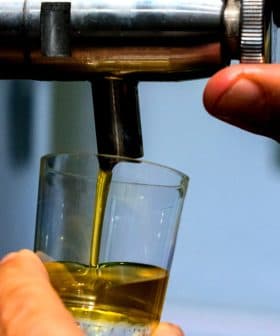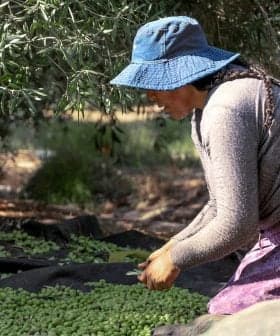The Indian Olive Oil Market Shows Potential, but Comes at a Price
Spain is well-positioned to capitalize on the growing market for olive oil in India. High tariffs on imported olive oils, however, present a major hurdle for Spanish producers.
 A tasting event for Spanish olive oils. Photo courtesy of the Interprofessional Olive Oil Association
A tasting event for Spanish olive oils. Photo courtesy of the Interprofessional Olive Oil AssociationA study by Spain’s ICEX found significant potential for olive oil in the Indian gourmet food market, with a rise in demand attributed to healthy eating trends, a growing middle class, and increased exposure to Mediterranean cuisine. Spain currently dominates the Indian olive oil market, but high prices due to tariffs remain a challenge for exporters, prompting efforts to brand olive oil as a gourmet product to increase consumption.
A new study from Spain’s Ministry of Industry, Commerce and Tourism (ICEX) has concluded there is a lot of potential for olive oil in the Indian gourmet food market.
“We are [also] convinced that this is a market with enormous potential,” Teresa Pérez, director of Spain’s Interprofessional Olive Oil Association, told Olive Oil Times. “You just have to review the evolution of sales to check that the consumption of olive oils is evolving very positively in India.”
The current problem (in India) is that the government has raised tariffs by 40 percent and, logically, consumption has suffered a lot.
The association was not directly involved with the ICEX study, but works to promote Spanish olive oil consumption around the world. ICEX did not respond to a request for comment on this story.
Olive oil currently represents 0.14 percent of the edible oils sold in India and is mainly purchased in urban areas of the world’s second most populous country. However, statistics from the country’s Ministry of Commerce show that olive oil imports have nearly quadrupled in the past decade, growing from 2,700 tons in 2009 to 9,300 tons in 2018.
“We assume that this is just the beginning,” Pérez said.
See Also:Olive Oil Trade NewsAccording to the ICEX report, a number of factors have come together to make demand for the product stronger. New healthy eating trends among Indians have led to an increased recognition of olive oil as a healthy alternative to other popular cooking and vegetable oils.
The rise of the country’s middle class, especially in urban areas, has also helped to fuel demand for gourmet foods and cooking products. According to the report, 70 percent of India’s demand for olive oil is concentrated around Delhi and Mumbai.
“We are talking about a huge country that currently has a middle class made up of some 300 million people,” Pérez said. “Consumers who, when they reach a certain level of life, give increasing importance to a healthy meal.”
She also attributed India’s rising demand for olive oil to travel, which has introduced many middle-class Indian consumers to Mediterranean cuisine and olive oil. Increasing levels of tourism was also cited by market analysts in neighboring China as one of the reasons the appetite for olive oil has grown among its middle class.
Pérez and Rafael Pico Lapuente, the director of the Spanish Association of the Olive Oil Exporting Industry and Commerce (Asoliva), both agreed that Spain is especially well poised to supply this growing market.
“Three of every four liters sold in India are olive oils from Spain,” Pérez said. “In total, last year we sold more than 7,000 tons in that immense country. It is clear that we have a very solid position in that market.”
The data overwhelmingly supports Pérez’s assessment. According to the Indian Ministry of Commerce, 76 percent of Indian olive oil imports came from Spain in 2018.
Spain also has more capacity to export to India’s emerging market than other large olive oil producing countries, according to Pico Lapuente. This is largely due to Spain’s increasing production over previous campaigns coupled with poor harvests in other large olive oil producing countries.
“Spain is the undisputed leader in all markets,” Pico Lapuente told Olive Oil Times. “In the case of India, we are also leaders.”
However, ICEX warned that high prices will remain a hurdle for olive oil producers exporting to the region. The report found that the vast majority of Indians’ spending habits are dictated by price, leaving olive oil well behind other cheaper cooking oils.
Forty percent of Indians surveyed in the report said that they bought olive oil in 250 milliliter bottles, allowing them to try out the product without making a larger financial commitment. Currently, 250 milliliter bottles of olive oil range in price from 230 Indian rupees ($3.33) to 600 rupees ($8.69).
Newly imposed and existing tariffs on olive oil imports to the country are mostly responsible for these high prices and have led to a decrease in the monetary value of virgin olive oil imports into India in recent years. However, the tariffs have not impacted the volumes of imported olive oil.
Pico Lapuente said these tariffs will be the largest hurdle for olive oil exporters trying to enter the market.
“India for us was and is an objective country to promote olive oils and increase their consumption,” Pico Lapuente said. “The current problem is that the government of India has raised tariffs by 40 percent and, logically, consumption has suffered a lot.”
“The last climb is inexplicable, considering that India has no production,” he added.
This is where branding olive oil as a gourmet food product comes in, according to Pérez. The Interprofessional Olive Oil Association is already working with other associations, including Asoliva and the Spanish Young Farmers Association (ASAJA), to target advertisements at specific demographics.
The Interprofessional Olive Oil Association combines digital, print, television and film advertising, along with other promotions to reach as many potential buyers as possible. This has included placing 20,000 advertising spots on Indian television as well as placing ads in eight large-scale print publications.
With all of this exposure to Spanish olive oil, Pérez is confident that consumption can continue to grow in spite of the tariffs.
“In view of the magnitude of the campaign, it is easy to understand the favorable evolution of that market,” Pérez said.









